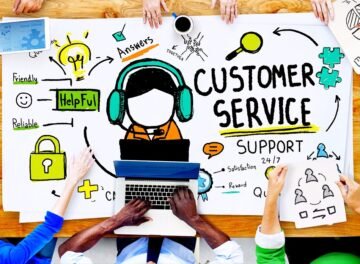Mastering Customer Service Excellence: Strategies for Building Strong Relationships

In today’s competitive business landscape, customer service is not just a department but a fundamental element of organizational success. Exceptional customer service can differentiate your brand, foster loyalty, and drive long-term growth. This article explores effective strategies for mastering customer service excellence, offering insights into building strong customer relationships, enhancing service quality, and creating a customer-centric culture.

Understanding Customer Service Excellence
- Defining Customer Service Excellence
Customer service excellence involves consistently delivering high-quality service that meets or exceeds customer expectations. It requires a deep understanding of customer needs, effective communication, and a commitment to continuous improvement. Excellence in customer service goes beyond resolving issues; it encompasses creating positive experiences, building trust, and fostering long-term relationships.
- The Impact of Customer Service on Business Success
Exceptional customer service can lead to increased customer satisfaction, loyalty, and advocacy. Satisfied customers are more likely to return, recommend your business to others, and contribute to positive word-of-mouth. Conversely, poor customer service can result in customer churn, negative reviews, and damage to your brand’s reputation. Investing in customer service excellence is essential for maintaining a competitive edge and achieving business success.
Key Strategies for Building Strong Customer Relationships
- Personalizing Customer Interactions
Personalization is a critical factor in building strong customer relationships. Tailor your interactions to individual customer preferences, needs, and history. Use customer data to provide personalized recommendations, address customers by name, and acknowledge previous interactions. Personalization demonstrates that you value your customers as individuals and can enhance their overall experience with your brand.
- Training and Empowering Customer Service Representatives
Investing in the training and development of your customer service team is essential for delivering exceptional service. Provide comprehensive training on product knowledge, communication skills, and problem-solving techniques. Empower your representatives with the authority to make decisions and resolve issues effectively. Well-trained and empowered employees are more confident and capable of delivering high-quality service.
- Implementing Effective Communication Channels
Offering multiple communication channels allows customers to reach out in their preferred way. Implement channels such as phone, email, live chat, and social media to provide convenient access to support. Ensure that these channels are integrated and that customer interactions are consistent across platforms. Timely and clear communication helps build trust and ensures that customer inquiries are addressed promptly.
- Utilizing Customer Feedback for Continuous Improvement
Customer feedback is a valuable source of information for improving service quality. Collect feedback through surveys, reviews, and direct interactions to gain insights into customer experiences and expectations. Analyze feedback to identify common issues, areas for improvement, and opportunities for innovation. Use this information to make data-driven decisions and enhance your service offerings.
Enhancing Service Quality
- Setting and Measuring Service Standards
Establishing clear service standards is crucial for maintaining consistency and quality. Define key performance indicators (KPIs) such as response time, resolution time, and customer satisfaction scores. Regularly measure and monitor these KPIs to ensure that service standards are met and identify areas for improvement. Setting high standards and tracking performance helps maintain a high level of service quality.
- Implementing Technology and Automation
Technology and automation can enhance service efficiency and effectiveness. Implement customer relationship management (CRM) systems to manage customer interactions, track service metrics, and analyze data. Use automation tools for tasks such as ticketing, follow-ups, and routine inquiries to streamline processes and reduce response times. Technology can also support personalization by providing access to customer data and preferences.
- Creating a Customer-Centric Culture
A customer-centric culture prioritizes the needs and preferences of customers in every aspect of the business. Foster a culture that values customer satisfaction and empowers employees to go above and beyond in their service efforts. Encourage collaboration between departments to ensure that customer needs are addressed comprehensively. A customer-centric culture promotes a unified approach to service excellence and drives positive outcomes.
Handling Difficult Situations and Complaints
- Approaching Complaints with Empathy and Understanding
Handling complaints effectively requires empathy and understanding. Listen actively to customers’ concerns, acknowledge their feelings, and express genuine regret for any inconvenience caused. Approach complaints as opportunities to resolve issues and improve service. Demonstrating empathy and a willingness to address concerns can turn a negative experience into a positive one and build customer loyalty.
- Implementing Effective Resolution Strategies
Develop clear procedures for resolving customer complaints and issues. Empower customer service representatives to handle complaints efficiently and provide solutions that meet or exceed customer expectations. Ensure that resolution strategies are fair, consistent, and transparent. Following up with customers after resolving their issues shows commitment to their satisfaction and helps build trust.
- Learning from Complaints to Prevent Future Issues
Complaints can provide valuable insights into areas for improvement. Analyze complaint trends to identify recurring issues and underlying causes. Use this information to implement changes and prevent similar problems in the future. Learning from complaints and taking proactive measures to address root causes demonstrates a commitment to continuous improvement and enhances overall service quality.
Building Long-Term Customer Loyalty
- Implementing Loyalty Programs and Rewards
Loyalty programs and rewards can incentivize repeat business and strengthen customer relationships. Design programs that offer meaningful benefits, such as discounts, exclusive offers, or points for purchases. Tailor rewards to align with customer preferences and behaviors. Effective loyalty programs encourage customer retention and create positive associations with your brand.
- Engaging Customers through Personalized Marketing
Personalized marketing involves using customer data to deliver relevant and targeted messages. Segment your customer base to create tailored marketing campaigns based on preferences, behaviors, and purchase history. Personalized communication helps build stronger connections and increases the likelihood of customer engagement and conversion.
- Maintaining Consistent Quality and Service
Consistency is key to building long-term customer loyalty. Ensure that service quality and customer experiences are consistently positive across all interactions. Maintaining high standards of service and delivering on promises fosters trust and reliability. Consistency reinforces your brand’s commitment to excellence and strengthens customer loyalty over time.
Conclusion
Mastering customer service excellence requires a comprehensive approach that encompasses personalization, effective communication, and continuous improvement. By implementing strategies to build strong relationships, enhance service quality, and handle difficult situations, businesses can create positive customer experiences and drive long-term success. Investing in customer service excellence not only differentiates your brand but also fosters loyalty and contributes to overall business growth. Embrace a customer-centric mindset and commit to delivering exceptional service at every touchpoint.


